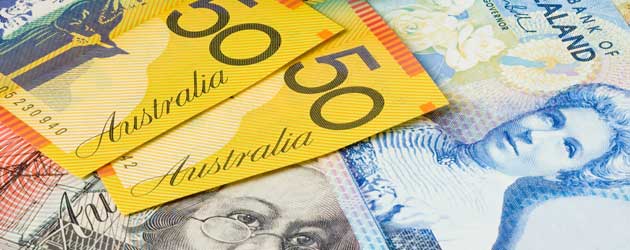 Anxieties initiated by the International Monetary Fund report published at the tail end of the week has caused trader risk appetite to diminish. Having soared amid healthy risk sentiment on Thursday, the Australian Dollar has lost its advance as investors seek safe-haven assets. Meanwhile, the Pound has gained a little momentum after trade balance data printed above expectations.
Anxieties initiated by the International Monetary Fund report published at the tail end of the week has caused trader risk appetite to diminish. Having soared amid healthy risk sentiment on Thursday, the Australian Dollar has lost its advance as investors seek safe-haven assets. Meanwhile, the Pound has gained a little momentum after trade balance data printed above expectations.
The Pound Sterling to Australian Dollar exchange rate is currently trending in the region of 1.8406.
Sterling movement was minimal on Thursday as trader focus was dominated by the soft US Dollar. A slight depreciation against high-yielding currencies was as a result of improved investor risk sentiment and a below forecast UK house price balance print. House Price Balance was expected to decline from 39.0% to 36.0% but the actual data fell to 30.0%.
The Pound firmed up a little after the Bank of England opted to hold interest rates at 0.50%. The decision was expected and already priced in, but the fact that they avoided any surprises was generally well received.
After the minutes from the Federal Reserve’s latest policy meeting were published the US Dollar softened against all of its major traded currency competitors. The dovish tone of the minutes fuelled trader risk appetite and high-yielding currencies, such as the Australian Dollar, benefitted.
Those gains were inevitably going to crumble, however, after Thursday’s Australian data printed poorly. The nation was forecast to have added 15, 500 new jobs, having gained 32,100 new positions in August, but the actual data showed a loss of -29,700 jobs in September. This, in turn, led to an unwanted increase in unemployment from 6.0% to 6.1%.
The Pound Sterling to Australian Dollar exchange rate has fallen to a low today of 1.8357.
A report from the International Monetary Fund has all but quashed Thursday’s influx of trader risk appetite. The report suggested that a fresh financial crisis could be triggered by excessive risk taking on global markets due to prolonged ultra-low interest rates.
José Viñals, the IMF’s financial counsellor, said: ‘Policymakers are facing a new global imbalance: not enough economic risk-taking in support of growth, but increasing excesses in financial risk-taking posing stability challenges.’
This report has pared the ‘Aussie’ (AUD) gains from Thursday and has seen traders flock to safe-haven assets.
With a significant dent in risk sentiment traders have been able to focus on yet more issues surrounding the South Pacific currency. China has decided to ratchet up import barriers in an effort to stem pollution and support domestic miners.
‘It makes Australian coal less competitive relative to China’s supply, and that’s at a time it’s already facing significant challenges, primarily due to the impact of lower prices squeezing margins,’ Phillip Chippindale, a Sydney-based analyst at Wilson HTM Investment Group Ltd., said by phone.
Sterling, meanwhile, has gained on better-than-expected trade balance data. Total Trade Balance was forecast to improve slightly from -£3079 to -£3000, but the actual result showed that the deficit narrowed to -£1917.
Forecast for the Pound to Australian Dollar Exchange Rate
As traders digest the various issues surrounding the Australian Dollar it is very likely that the GBP/AUD exchange rate will continue to advance. However, several speeches from Bank of England officials may alter the situation if they hold dovish overtones. Given that the BoE want to see the Pound’s value drop, it would be unsurprising to see an attempt to talk Sterling down.
The Pound Sterling to Australian Dollar exchange rate has reached a high today of 1.8430.
Australian Dollar (AUD) Exchange Rates
[table width=”100%” colwidth=”50|50|50|50|50″ colalign=”left|left|left|left|left”]
Currency, ,Currency,Rate ,
Australian Dollar, ,US Dollar,0.8717,
,US Dollar,0.8717,
Australian Dollar, ,Euro,0.6881,
,Euro,0.6881,
Australian Dollar, ,Pound,0.5430,
,Pound,0.5430,
Australian Dollar, ,New Zealand Dollar,1.1143,
,New Zealand Dollar,1.1143,
[/table]

